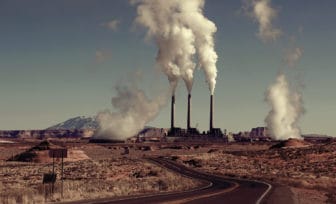We published a ProPublica article Thursday that focused on the environmental impact of Arizona’s Navajo Generating Station — the West’s largest power-generating facility.
ProPublica called the plant “more a caution than a marvel, showing how much energy it takes to move water through an artificial river system, and the unforeseen damage produced by doing so.”
I wanted to know more about the economic impact the plant has in nearby Native communities, including the Navajo Nation that extends into New Mexico. I’ve learned as a journalist that environmental and economic concerns — at least in the short-term — don’t always match up in the views of advocates on all sides of a debate.
Not surprisingly, I discovered that the power plant has an important economic impact.
The plant and the nearby Kayenta mine, which produces the plant’s coal, provide jobs for 850 Native Americans, according to a report produced for the Department of the Interior in 2012. Total wages and benefits to the Native employees are nearly $100 million a year.
The power plant’s website touts “good jobs near ancestral homes — and economic independence” for Native Americans. It says Natives hold nearly 85 percent of its jobs.
“In addition, the Kayenta mine also makes annual payments of just over $50 million per year to the Navajo Nation and Hopi Tribe ($13 million to Hopi, $37 million to Navajo) for coal royalties and bonuses, groundwater usage, and purchase of electricity from the Navajo Tribal Utility Authority,” the Interior Department report states. “Additional benefits for the tribes include several hundred thousand dollars per year in scholarship funds, and local property taxes which primarily go to schools in the region. SRP (the plant’s parent company) also pays the Navajo Nation about $1 million/year in lease and air permit fees for the Navajo GS itself.”
Here’s evidence of the significance of the jobs: One of the top Native American news outlets in America, Indian Country Today, has profiled workers who have taken the power plant’s training program and shared how people can apply.
The power plant is in transition, largely due to the environmental issues the ProPublica article highlighted. As High Country News reported in 2013, a coalition of environmental and Native American groups proposed a compromise plan to reduce emissions from the plant while keeping it open until 2044.
Those efforts were successful. From ProPublica:
The plant’s environmental toll is sure to fuel arguments for its eventual closing. For now, it has been granted a reprieve from complying with the Obama administration’s new Clean Power initiative, which requires Arizona to reduce its carbon output by 52 percent. But the Environmental Protection Agency has said that it expects to work with the Navajo tribe to reduce emissions separately from Arizona’s mandate, and will likely revisit that issue in the future. The plant will also soon be subject to a new federal environmental review process triggered by its renewed lease on Navajo lands.
There’s good reason many want to protect the jobs the plant and mine provide. Some 43 percent of people on the Navajo Nation live below the poverty level, and 42 percent are unemployed, according to the Navajo Nation’s official statistics. The Navajo Nation has a population of about 180,000.
That poverty rate is more than twice New Mexico’s rate of 20 percent. The U.S. average is about 15 percent.
